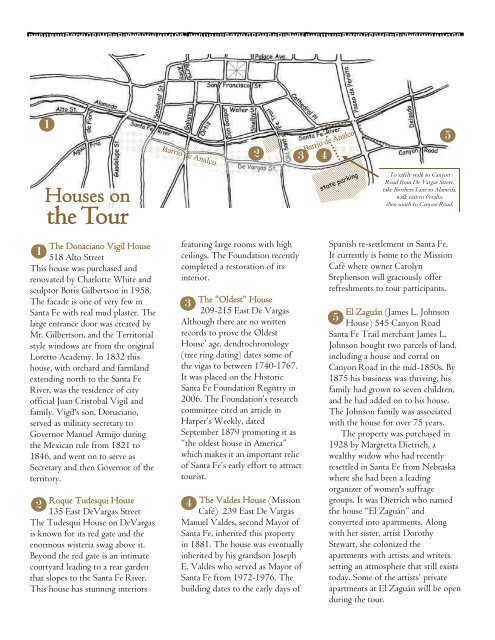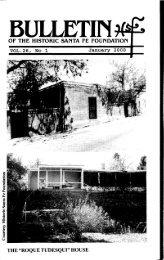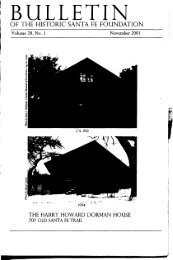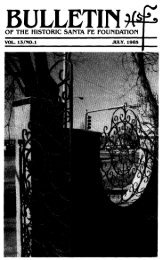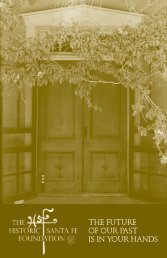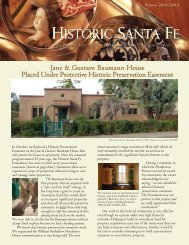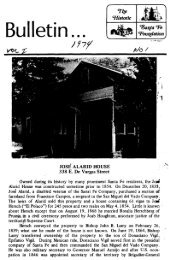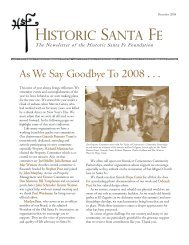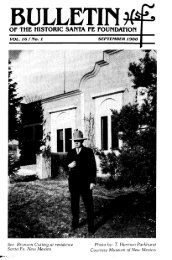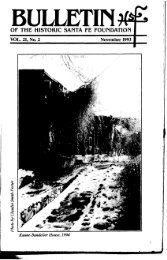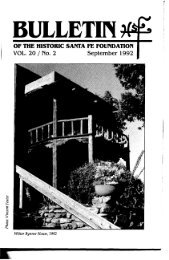HISTORIC TOUR - Historic Santa Fe Foundation
HISTORIC TOUR - Historic Santa Fe Foundation
HISTORIC TOUR - Historic Santa Fe Foundation
Create successful ePaper yourself
Turn your PDF publications into a flip-book with our unique Google optimized e-Paper software.
1<br />
Barrio de Analco<br />
2<br />
3<br />
Barrio de Analco<br />
4<br />
5<br />
Houses on<br />
the Tour<br />
The Donaciano Vigil House<br />
1<br />
518 Alto Street<br />
This house was purchased and<br />
renovated by Charlotte White and<br />
sculptor Boris Gilbertson in 1958.<br />
The facade is one of very few in<br />
<strong>Santa</strong> <strong>Fe</strong> with real mud plaster. The<br />
large entrance door was created by<br />
Mr. Gilbertson, and the Territorial<br />
style windows are from the original<br />
Loretto Academy. In 1832 this<br />
house, with orchard and farmland<br />
extending north to the <strong>Santa</strong> <strong>Fe</strong><br />
River, was the residence of city<br />
official Juan Cristobal Vigil and<br />
family. Vigil's son, Donaciano,<br />
served as military secretary to<br />
Governor Manuel Armijo during<br />
the Mexican rule from 1821 to<br />
1846, and went on to serve as<br />
Secretary and then Governor of the<br />
territory.<br />
Roque Tudesqui House<br />
2<br />
135 East DeVargas Street<br />
The Tudesqui House on DeVargas<br />
is known for its red gate and the<br />
enormous wisteria swag above it.<br />
Beyond the red gate is an intimate<br />
courtyard leading to a rear garden<br />
that slopes to the <strong>Santa</strong> <strong>Fe</strong> River.<br />
This house has stunning interiors<br />
featuring large rooms with high<br />
ceilings. The <strong>Foundation</strong> recently<br />
completed a restoration of its<br />
interior.<br />
The “Oldest” House<br />
3<br />
209-215 East De Vargas<br />
Although there are no written<br />
records to prove the Oldest<br />
House’ age, dendrochronology<br />
(tree ring dating) dates some of<br />
the vigas to between 1740-1767.<br />
It was placed on the <strong>Historic</strong><br />
<strong>Santa</strong> <strong>Fe</strong> <strong>Foundation</strong> Registry in<br />
2006. The <strong>Foundation</strong>’s research<br />
committee cited an article in<br />
Harper’s Weekly, dated<br />
September 1879 promoting it as<br />
“the oldest house in America”<br />
which makes it an important relic<br />
of <strong>Santa</strong> <strong>Fe</strong>’s early effort to attract<br />
tourist.<br />
4<br />
The Valdes House (Mission<br />
Café) 239 East De Vargas<br />
Manuel Valdes, second Mayor of<br />
<strong>Santa</strong> <strong>Fe</strong>, inherited this property<br />
in 1881. The house was eventually<br />
inherited by his grandson Joseph<br />
E. Valdes who served as Mayor of<br />
<strong>Santa</strong> <strong>Fe</strong> from 1972-1976. The<br />
building dates to the early days of<br />
state parking<br />
To safely walk to Canyon<br />
Road from De Vargas Street,<br />
take Brothers Lane to Alameda,<br />
walk east to Peralta,<br />
then south to Canyon Road.<br />
Spanish re-settlement in <strong>Santa</strong> <strong>Fe</strong>.<br />
It currently is home to the Mission<br />
Café where owner Carolyn<br />
Stephenson will graciously offer<br />
refreshments to tour participants.<br />
El Zaguán (James L. Johnson<br />
5<br />
House) 545 Canyon Road<br />
<strong>Santa</strong> <strong>Fe</strong> Trail merchant James L.<br />
Johnson bought two parcels of land,<br />
including a house and corral on<br />
Canyon Road in the mid-1850s. By<br />
1875 his business was thriving, his<br />
family had grown to seven children,<br />
and he had added on to his house.<br />
The Johnson family was associated<br />
with the house for over 75 years.<br />
The property was purchased in<br />
1928 by Margretta Dietrich, a<br />
wealthy widow who had recently<br />
resettled in <strong>Santa</strong> <strong>Fe</strong> from Nebraska<br />
where she had been a leading<br />
organizer of women's suffrage<br />
groups. It was Dietrich who named<br />
the house “El Zaguán” and<br />
converted into apartments. Along<br />
with her sister, artist Dorothy<br />
Stewart, she colonized the<br />
apartments with artists and writers<br />
setting an atmosphere that still exists<br />
today. Some of the artists’ private<br />
apartments at El Zaguán will be open<br />
during the tour.


